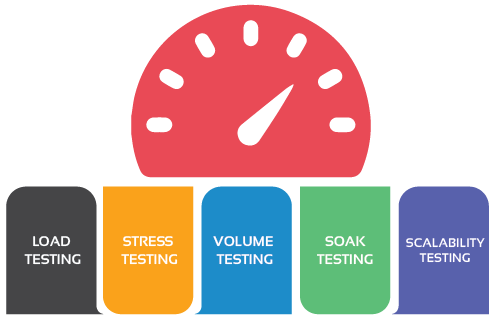Performance testing is a form of software testing that focuses on the way the system operating the system performs under a particular load. This isn't about finding software bugs or flaws. Performance testing measures based on benchmarks and standards. Performance testing should give developers the diagnostic information that they need to eliminate bottlenecks.
Types of performance testing for applications
To understand how applications will perform on customers' systems, there different types of performance tests which may be implemented during testing. This is non-functional testing, which was made to determine the openness of a method. (Functional testing concentrates on different functions of applications.)

Load testing
Load testing measures system performance as the workload increases. That workload could indicate concurrent customers or transactions. The system is tracked to measure response time and system remaining power as workload increases.
Stress testing
Unlike load testing, pressure testing -- also known as fatigue testing -- is supposed to measure system performance out the parameters of normal working conditions. The program is given more users or transactions that can be handled. The goal of stress testing is to assess the software stability. At exactly what point does software neglect, and how does the software recover from collapse?
Spike testing
Spike testing is a type of stress testing which assesses software functionality when workloads are considerably increased quickly and repeatedly. The workload is beyond ordinary expectations for short amounts of time.
Endurance testing
Endurance testing -- also called soak testing -- is an assessment of the way that software performs with a normal workload within a protracted amount of time. The goal of endurance testing would be to check for system problems like memory leaks. (A memory leak occurs when a system fails to release lost memory. The memory leak can impair system performance or make it fail.)
Scalability testing
Scalability testing is utilized to decide if software is effectively handling increasing workloads. This may be figured out by slowly adding to the consumer load or information volume while tracking system performance. Also, the workload may remain at the exact same level while tools such as CPUs and memory have been changed.
Volume testing
Volume testing determines how efficiently software performs with a large, estimated amounts of information. It's also known as flood testing since the evaluation floods the system with data.

Most Frequent Problems Observed in Performance Testing
During performance testing of applications, developers are looking for functionality symptoms and issues.
Speed issues -- slow responses and lengthy load times such as -- frequently are observed and addressed. But there are other performance problems that can be observed:
Bottle necking -- This occurs when information flow is interrupted or stopped since there is not enough capacity to handle the workload.
Poor scalability -- When software cannot handle the desired variety of concurrent tasks, results could be delayed, errors could increase, or other unexpected behavior could happen that affects:
- Disk utilization
- CPU usage
- Performance escapes
- Operating system limitations
- Poor network setup
Computer software configuration issues -- Often settings are not set at a decent level to deal with the workload.
Insufficient hardware tools -- Performance testing may reveal physical memory constraints or low-performing CPUs.
Comments
Post a Comment